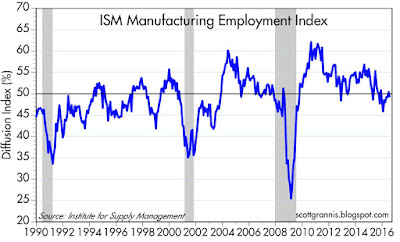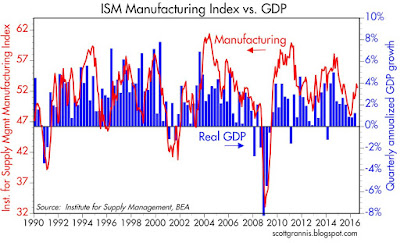Since late October 2008, I have been arguing that the main objective of the Fed's Quantitative Easing program was
not to provide monetary stimulus, but rather to satisfy very strong money demand. I've fleshed out the argument many times over the years, with a few examples
here,
here, and
here.
A short version of the argument goes like this: The true objective of Quantitative Easing was not to "print money." Instead, it was to convert notes and bonds into bank reserves (now effectively T-bill equivalents, since they pay interest) in order to meet the economy's tremendous demand for liquid, default-free, interesting-bearing securities. QE dramatically expanded the supply of "money" at a time when the market's demand for money was almost insatiable. Milton Friedman taught us that inflation results when the supply of money exceeds the demand for it. The evidence to date speaks for itself: we have seen no increase in inflation despite an enormous increase in the monetary base, so it must be the case that QE served mainly to supply money that the market wanted to hold.
In any event, QE could never be stimulative, because you can't expand the output of an economy by expanding its supply of money; pumping money into an economy in excess of what's demanded simply serves to inflate the price level. So it makes little or no sense to argue that the Fed (or any other central bank that has engaged in QE) is powerless to stimulate the economy. QE wasn't a failure, it was absolutely necessary, and it worked: if the Fed hadn't undertaken QE there would have been a serious shortage of money, and that could have prolonged the recession and created lots of deflation.
QE was a response to something that triggered a huge demand for money, and that "something" was a major shock to confidence. Terrified of the prospect of another financial market meltdown and another global recession, people—and especially banks—wanted a safe place to hide, and there were not enough T-bills to go around at the time QE launched. (Recall that by June 2008 the Fed had sold virtually all of its holdings of T-bills in response to the market's demand for them.) Moreover, in the years following the Great Recession, Treasury significantly reduced its issuance of T-bills in favor of longer-term securities in a rational response to the historically low level of Treasury yields.
Even though confidence has gradually returned as the economy has recovered, it's quite likely that banks' appetite for excess bank reserves will remain very strong because of increased regulatory requirements, as I noted
earlier this year. At least half of the $2.2 trillion of excess reserves currently held by major banks likely is needed just to meet risk-weighted capital requirements imposed by Dodd-Frank and the Basel Accords, plus the Fed-imposed requirement that banks hold highly liquid assets (mainly bank reserves) equal to 100% of the amount that Fed stress tests indicate they would need to survive another liquidity crisis. As for the rest, banks are still—obviously—reluctant to lend anywhere near as much as their abundant holdings of excess reserves would allow.
Here are some up-to-date charts that illustrate and explain the increased demand for money:

The chart above is my preferred way to measure the demand for money. It compares the level of the M2 money supply to the level of nominal GDP. The ratio of M2 to nominal GDP is akin to the percentage of annual income that the average person holds in the form of "money." For many years, from 1960 through the late 1980s, this ratio was relatively stable. It declined in the 1990s due to the fallout from the S&L crisis. Since 2001, however, it has risen steadily and is now at its highest level ever.

The chart above shows the current composition of M2: retail money market funds, small time deposits, currency in circulation, retail checking accounts, and bank savings deposits. The mix of these components has changed over time, but the sum is a good representation of the amount of highly liquid, easily spendable "money" that is held by the public.

The chart above compares the level of M2 to the level of nominal GDP, with both measured using a semi-log scale. While the ratio of M2 to GDP has wobbled quite a bit over the years, over a period of almost 60 years the two have increased by almost the same amount. (Note that the two y-axes are offset by a factor of 1.75.) This makes intuitive sense, since the larger the economy, the higher are incomes, and the more money is needed to make everything work. The gap at the right hand side of the chart suggests that there is about $2.3 trillion of "extra" M2 money in the system, most of which is held in the form of bank savings deposits, which now represent about two-thirds of M2, as compared to about 50% in the early 2000s.
In other words, people are happily "hoarding" some $2.3 trillion of extra money relative to their incomes, most of that in bank savings deposits which pay almost nothing in the way of interest. (That the public is happy to hold some $8.6 trillion in bank savings deposits despite the fact that they pay almost nothing is a powerful illustration of just how strong the demand for money is.) Should they lose the desire to hold that money, and decide instead to spend it, nominal GDP could grow by as much as $4 trillion (2.3 * 1.75) if past relationships were to reestablish themselves. Much of that growth would likely come in the form of higher prices, while some would come from stronger real growth—because declining money demand, the flip side of rising confidence, would likely go hand in hand with
increased investment, which has been sorely lacking during this recovery.
The following charts demonstrate that despite all the trillions of bonds the Fed has purchased, the amount of money in the economy has not grown any faster under a QE regime than it has over the past six decades:
We start with the expansion of the Fed's balance sheet, a simplified version of which is shown in the chart above. The blue bars represent positions at the beginning of 2007, well before the onset of the 2008 financial crisis and the launch of Quantitative Easing. The red bars show positions as of the Fed's latest report. Thus, the era of Quantitative Easing, which began in October 2008, saw the Fed on net purchase almost $3 trillion of Treasuries and MBS. This resulted in an increase of about $2.4 billion in bank reserves and an increase of about $600 billion in the amount of currency in circulation. (Banks can exchange their bank reserves for currency whenever they want.)
The chart above shows the growth of bank reserves, which grew from almost $100 billion in September 2008 to just over $2.4 trillion today.
Because of the expansion of the money supply (which increases required reserves) and the modest shrinkage in the Fed's balance sheet over the past few years, excess bank reserves have declined by almost 20% since their high two years ago. And the sky hasn't fallen.
The monetary base, which is the sum of bank reserves and currency in circulation, and which in effect represents the high-powered money that the Fed has created via its purchases of notes and bonds, has expanded from about $900 billion in September 2008 to just over $3.8 trillion today.
The Fed massively expanded its balance sheet and massively grew the supply of reserves and high-powered money. But contrary to popular belief, there was NOT a similar explosion of growth in the money supply. What happened was that banks were happy to lend their deposit inflows to the Fed, rather than to the private sector. As I explained
here, banks took in $4 trillion of savings deposits and used that cash to purchase notes and bonds which were in turn sold to the Fed in exchange for bank reserves. That is why Fed purchases did not create massive amounts of new money: banks were happy to boost their holdings of bank reserves.

The chart above is the proof. For almost six decades, the M2 money supply has grown at an annualized rate of 6.9%. During the period of Quantitative Easing, M2 grew at about the same rate as it has grown since 1960.
Looking more closely, in the above chart, we can see that M2 has grown by an annualized 6.5% since early 2007 and since QE began in late 2008. A slower rate, in fact, than it has averaged since 1960.
The Fed's Quantitative Easing regime is broadly misunderstood. It was not about stimulus, it was instead about satisfying an amazing and unprecedented increase in public's and the banking system's demand for safe, interest-bearing assets.
It may all end in tears, if the demand for money should decline and should the Fed fail to take timely and sufficient measures to offset the decline in banks' demand for excess reserves (by shrinking its balance sheet and/or raising the interest rate it pays on excess reserves), but for now things look OK.

















































